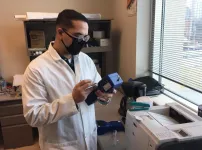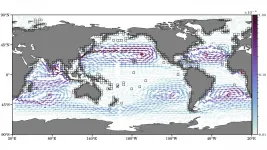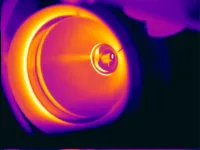(Press-News.org) If you're looking for an indoor space with a low level of particulate air pollution, a commercial airliner flying at cruising altitude may be your best option. A newly reported study of air quality in indoor spaces such as stores, restaurants, offices, public transportation -- and commercial jets -- shows aircraft cabins with the lowest levels of tiny aerosol particles.
Conducted in July 2020, the study included monitoring both the number of particles and their total mass across a broad range of indoor locations, including 19 commercial flights in which measurements took place throughout departure and arrival terminals, the boarding process, taxiing, climbing, cruising, descent, and deplaning. The monitoring could not identify the types of the particles and therefore does not provide a direct measure of coronavirus exposure risk.
"We wanted to highlight how important it is to have a high ventilation rate and clean air supply to lower the concentration of particles in indoor spaces," said Nga Lee (Sally) Ng, associate professor and Tanner Faculty Fellow in the School of Chemical and Biomolecular Engineering and the School of Earth and Atmospheric Sciences at the Georgia Institute of Technology. "The in-flight cabin had the lowest particle mass and particle number concentration."
The study, believed to be the first to measure both size-resolved particle mass and number in commercial flights from terminal to terminal and a broad range of indoor spaces, has been accepted for publication in the journal Indoor Air and posted online at the journal's website. Supported by Delta Air Lines, the research may be the first to comprehensively measure particle concentrations likely to be encountered by passengers from terminal to terminal.
As scientists learn more about transmission of the coronavirus, the focus has turned to aerosol particles as an important source of viral spread indoors. Infected people can spread the virus as they breathe, talk, or cough, creating particles ranging in size from less than a micron -- one millionth of a meter -- to 1,000 microns. The larger particles quickly fall out of the air, but the smaller ones remain suspended.
"Especially in poorly ventilated spaces, these particles can be suspended in the air for a long period of time, and can travel to every corner of a room," Ng said. "If they are viral particles, they can infect people who may be at a considerable distance from a person emitting the particles."
To better understand the circulation of airborne particles, Delta approached Ng to conduct a study of multiple indoor environments, with a strong focus on air travel conditions. Using handheld instruments able to measure the total number of particles and their mass, Georgia Tech researchers examined air quality in a series of Atlanta area restaurants, stores, offices, homes, and vehicles -- including buses, trains, and private automobiles.
They trained Delta staff to conduct the same type of measurements in terminals, boarding areas, and a variety of aircraft through all phases of flight. The Delta staff recorded their locations as they moved through the terminals, and the instruments produced measurements consistent with the restaurants and stores they passed on their way to and from boarding and departure gates.
"The measurements started as soon as they stepped into the departure terminal," Ng said. "We were thinking about the whole trip, what a person would encounter from terminal to terminal."
In flight, aircraft air is exchanged between 10 and 30 times per hour. Some aircraft bring in exclusively outside air, which at cruising altitude is largely free of pollutant particles found in air near the ground. Other aircraft mix outdoor air with recirculated air that goes through HEPA filters, which remove more than 99% of particles.
In all, the researchers evaluated measurements from 19 commercial flights with passenger loads of approximately 50%. The flights included a mix of short- and medium-length flights, and aircraft ranging from the CRJ-200 and A220 to the 757, A321, and 737.
Among all the spaces measured, restaurants had the highest particle levels because of cooking being done there. Stores were next, followed by vehicles, homes, and offices. The average sub-micron particle number concentration measured in restaurants, for instance, was 29,400 particles per cubic centimeter, and in offices it was 2,473 per cubic centimeter.
"We have quite a comprehensive data set to look at the size distribution of particles across these different spaces," Ng said. "We can now compare indoor air quality in a variety of different spaces."
Because of the portable instruments used, the researchers were unable to determine the source of the particles, which could have included both biological and non-biological sources. "Further studies can include direct measurements of viral loads and tracing particle movements in indoor spaces," she added.
Jonathan Litzenberger, Delta's managing director of Global Cleanliness Strategy, said the research helps advance the company's goals of protecting its customers and employees.
"Keeping the air clean and safe during flight is one of the most foundational layers of protection Delta aims to provide to our customers and employees," he said. "We are always working to better understand the travel environment and confirm that the measures we are implementing are working."
Overall, the study highlights the importance of improving indoor air quality as a means of reducing coronavirus transmission.
"Regardless of whether you are in an office or an aircraft, having a higher ventilation rate and good particle filtration are the keys to reducing the total particle concentration," said Ng. "That should also reduce the concentration of any viral particles that may be present."
INFORMATION:
In addition to Ng, the researchers included Jean C. Rivera-Rios, Taekyu Joo, Masayuki Takeuchi, and Thomas M. Orlando from Georgia Tech; and Tracy Bevington, John W. Mathis, Clifton D. Pert, Brandon A. Tyson, Tyler M. Anderson-Lennert, and Joshua A. Smith from Delta Air Lines.
CITATION: Jean C. Rivera-Rios, et al, "In-flight particulate matter concentrations in commercial flights are likely lower than other indoor environments." (Indoor Air, 2021) https://doi.org/10.1111/ina.12812.
Finding innovative and sustainable solutions to our material needs is one of the core objectives of green chemistry. The myriad plastics that envelop our daily life - from mattresses to food and cars - are mostly made from oil-based monomers which are the building blocks of polymers. Therefore, finding bio-based monomers for polymer synthesis is attractive to achieve more sustainable solutions in materials development.
In a paper published in ACS Sustainable Chemistry & Engineering, researchers from the Kleij group present a new route to prepare biobased polyesters with tuneable properties. The researchers ...
Insects can reprogram plant growth, transforming ordinary plant parts into intricately patterned shelters that are safe havens for feeding and reproduction.
These structures, called galls, have fascinated biologists for centuries. They're crafted by a variety of insects, including some species of aphids, mites, and wasps. And they take on innumerable forms, each specific in shape and size to the insect species that's created it - from knobs to cone-shaped protrusions to long, thin spikes. Some even resemble flowers.
Insects create galls by manipulating the development of plants, but figuring out exactly how they perform this feat "feels like ...
The backbone is the Swiss Army Knife of mammal locomotion. It can function in all sorts of ways that allows living mammals to have remarkable diversity in their movements. They can run, swim, climb and fly all due, in part, to the extensive reorganization of their vertebral column, which occurred over roughly 320 million years of evolution.
Open any anatomy textbook and you'll find the long-standing hypothesis that the evolution of the mammal backbone, which is uniquely capable of sagittal (up and down) movements, evolved from a backbone that functioned ...
WASHINGTON, March 2, 2021 -- Tons of plastic debris get released into the ocean every day, and most of it accumulates within the middle of garbage patches, which tend to float on the oceans' surface in the center of each of their regions. The most infamous one, known as the Great Pacific Garbage Patch, is in the North Pacific Ocean.
Researchers in the U.S. and Germany decided to explore which pathways transport debris from the coasts to the middle of the oceans, as well as the relative strengths of different subtropical gyres in the oceans and how they influence long-term accumulation of debris.
In Chaos, from AIP Publishing, Philippe Miron, Francisco Beron-Vera, Luzie Helfmann, and Peter Koltai report creating a Markov chain ...
What The Study Did: This study investigates emergency department visits for violence-related injuries occurring at home and outside the home in Cardiff, Wales, before and after COVID-19 lockdown measures were instituted in March 2020.
Authors: Jonathan P. Shepherd, Ph.D., Crime and Security Research Institute at Cardiff University in Wales, is the corresponding author.
To access the embargoed study: Visit our For The Media website at this link https://media.jamanetwork.com/
(doi:10.1001/jama.2020.25511)
Editor's Note: Please see the article for additional information, including other authors, author contributions ...
In a mouse study, Australian researchers have mapped out what happens behind the scenes in fat tissue during intermittent fasting, showing that it triggers a cascade of dramatic changes, depending on the type of fat deposits and where they are located around the body.
Using state-of-the-art instruments, University of Sydney researchers discovered that fat around the stomach, which can accumulate into a 'protruding tummy' in humans, was found to go into 'preservation mode', adapting over time and becoming more resistant to weight loss.
The findings are published today in Cell Reports.
A research team led by Dr Mark Larance examined fat tissue types from different locations to understand their role during every-other-day fasting, ...
The first UK COVID-19 lockdown saw a "rapid and sustained" fall in violence outside the home in the Welsh capital city, a new study led by Cardiff University has shown.
Researchers from Cardiff University's Crime and Security Research Institute (CSRI) and the US Centers for Disease Control and Prevention studied data from Cardiff's sole emergency department (ED) from March to June 2020 and compared it to weekly data from January 2019 onwards.
They found there were almost 60% fewer attendances per week for violent injury outside the home in the first lockdown during ...
WASHINGTON, March 2, 2021 -- When a vehicle travels over a wet or flooded road, water builds up in front of the tire and generates a lift force. In a phenomenon known as hydroplaning, this force can become large enough to lift the vehicle off the ground.
In Physics of Fluids, by AIP Publishing, scientists from the CNRS, the University of Lyon, and The Michelin Group use a laser imaging technique to study water flow in front of and through tire grooves.
To counteract hydroplaning, tread designs are chosen to drain water from the front of the tire without decreasing its ability to adhere to the road. Very few quantitative experimental studies of the movement of water through tire grooves have been done, so little is known about the exact flow patterns in ...
What The Study Did: This study suggests that, during the COVID-19 pandemic, a hotel- based isolation and quarantine strategy that delivers integrated medical and behavioral health support to people experiencing homelessness can be done safely outside the hospital setting.
Authors: Jonathan D. Fuchs, M.D., M.P.H., of the San Francisco Department of Public Health, is the corresponding author.
To access the embargoed study: Visit our For The Media website at this link https://media.jamanetwork.com/
(doi:10.1001/jamanetworkopen.2021.0490)
Editor's Note: The article includes conflict of interest and funding/support disclosures. Please see the article for additional information, including other authors, author contributions and affiliations, conflict of interest ...
What The Study Did: Wearing surgical face masks for 30 minutes was not associated with changes in respiratory parameters or clinical signs of respiratory distress in this study of 47 infants and young children in Italy.
Authors: Silvia Bloise, M.D., of Sapienza University of Rome in Italy, is the corresponding author.
To access the embargoed study: Visit our For The Media website at this link https://media.jamanetwork.com/
(doi:10.1001/jamanetworkopen.2021.0414)
Editor's Note: Please see the article for additional information, including other authors, author contributions and ...






